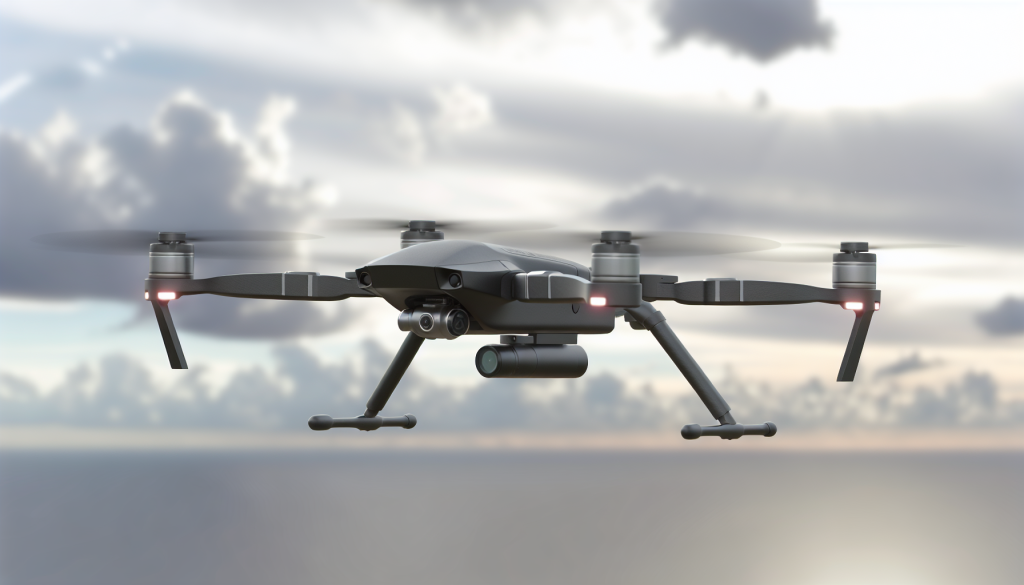Why in the News?
Recently, Adani Defence and Aerospace made headlines by introducing the Drishti 10 Starliner Unmanned Aerial Vehicle (UAV) specifically designed for the Indian Navy. This innovative UAV marks a significant step forward in India’s indigenous defense capabilities.
More on the News
- The UAV embarked on its inaugural journey from Hyderabad to Porbandar, officially integrating into naval maritime operations.
- Notably, this is the Indian Navy’s first indigenously manufactured UAV, boasting over 60% indigenous content.
- Its introduction is expected to enhance the Navy’s Maritime Domain Awareness (MDA), significantly bolstering efforts in anti-piracy and seaborne missions.
Key Features:
- Advanced Intelligence, Surveillance, and Reconnaissance (ISR) Platform: The Drishti 10 Starliner serves as a versatile ISR platform.
- Medium Altitude Long Endurance (MALE) UAV: It is designed for extended flight durations and high-altitude operations.
- 450 kg Payload Capacity: This allows for the inclusion of various sensors and systems to fulfill its operational role.
- Received STANAG 4671 Certification: This certification aligns the UAV with NATO’s standardization agreements, showcasing its credibility and reliability.
The introduction of the Drishti UAV underscores the growing significance of drone technology in enhancing national security.
Role of Drones in National Security
Drones are revolutionizing how countries approach defense and law enforcement for several reasons:
- Surveillance and Intelligence: Drones enable remote surveillance and intelligence-gathering operations, crucial for national security agencies.
- Offensive Military Operations: They can carry out strikes on enemy targets, extending military reach into inhospitable terrains.
- Replacing Manned Aircraft: Utilization of drones alleviates risks to pilots and allows missions to be conducted more efficiently.
- Military Logistics: The Indian army is increasingly replacing traditional logistics methods with drones for supply deliveries in challenging terrains, particularly along the Line of Actual Control (LAC).
- Force Multiplication: Equipped with AI capabilities, drones can communicate, engage in Automatic Target Recognition (ATR), and execute operations alongside ground forces.
- Maintaining Law and Order: Police forces are adopting drones for monitoring crowds, surveillance of illegal activities, and conducting search and rescue operations.
Concerns Associated with Drone Technology
While drones offer numerous advantages, they also introduce specific concerns:
-
Threat to National Security: Rogue elements acquiring UAV technology pose substantial risks.
- There have been instances of cross-border drone infiltration for smuggling explosives and other illicit goods.
- Rogue drones can also threaten civilian airspace and infrastructure, including critical sites like nuclear facilities.
-
Shortage of Skilled Personnel: The demand for trained drone operators and engineers far outpaces supply, creating a skills gap in the industry.
-
GPS-Denied Environments: Many imported drones depend on GPS technology, leading to operational challenges in areas where GPS signals are compromised (e.g., Heron Mk II UAVs).
-
Battery Shortages: Advanced lithium-ion batteries are favored for drones due to weight constraints, yet development is still in its infancy.
-
Ethical and Moral Concerns: The use of drones in military operations has raised debates about their impact on civilian populations, particularly influenced by controversial long-range attacks by foreign military forces.
Drone Regulations in India
India has initiated regulatory frameworks to address drone usage in national airspace:
-
National Counter Rogue Drone Guidelines (2019): These guidelines were established by the Ministry of Civil Aviation to assess and tackle drone threats.
-
Drone Rules 2021: This regulation categorizes Indian airspace into green, yellow, and red zones, stipulating where drones can operate. Notably, red zones are classified as no-fly areas without prior government permission.
India’s Initiatives for Drone Technology in the Defense Sector
India is making significant strides to enhance its drone capabilities through various initiatives:
-
Acquisition of Foreign Drones: India has actively sourced drone technology from countries such as the US and Israel.
- Heron Mark-II Drones: These medium-altitude drones are used primarily for surveillance along sensitive northern borders.
- Searcher Mk II Drones: Developed by Israel Aerospace Industries, these drones serve reconnaissance purposes for the Indian army and navy.
-
Drone, Detect, Deter and Destroy (D4 System): This indigenous anti-drone system, developed by DRDO, has been integrated into the Indian Armed Forces.
-
Border Security: The BSF has deployed various anti-drone systems, both static and vehicle-mounted, to mitigate rising threats along the Indo-Pak border.
-
Indigenous UAV Development: DRDO continues to work on UAV systems at different stages of development, promoting self-reliance in drone technology.
Indigenous Drones of DRDO
India’s DRDO has developed several indigenous drone systems:
-
DRDO Lakshya: A target drone for secret aerial reconnaissance and target acquisition, operated by a solid propellant rocket motor.
-
DRDO Nishant: A versatile UAV capable of battlefield surveillance, reconnaissance, and target tracking, launched via a mobile hydro pneumatic launcher, featuring day/night operational capabilities.
-
RUSTOM-1: A short-range UAV system designed for intelligence, surveillance, and reconnaissance missions, weighing approximately 800 kg.
-
TAPAS/Rustom-2: A medium-altitude, long-endurance UAV developed for intelligence, surveillance, and reconnaissance applications, currently in advanced stages of testing.
-
Archer: A weaponized UAV aimed at surveillance, reconnaissance, and operations in low-intensity conflicts.
Way Forward
To further harness drone technology, several strategies are essential:
-
Research and Development: Streamlining processes for quicker development and deployment of indigenous UAV and counter-UAV technologies.
-
Private Sector Involvement: Enhancing local manufacturing capabilities to reduce dependency on imports and encouraging defense startups through initiatives like the Innovations for Defence Excellence (iDEX) initiative.
-
Tri-Service Framework: Establishing a joint doctrinal framework for drone deployment among the armed forces to ensure cohesive operations and clearly defined accountability.

